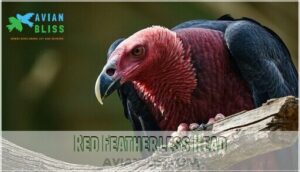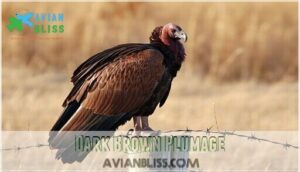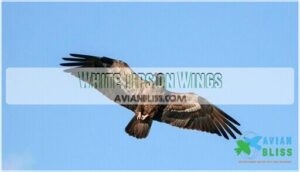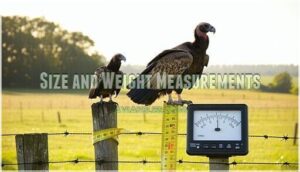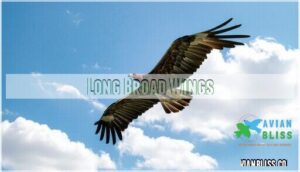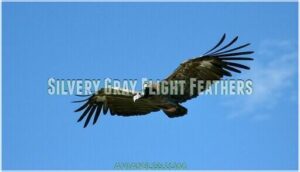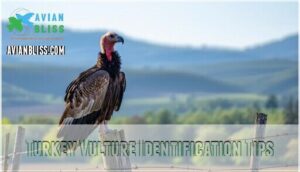This site is supported by our readers. We may earn a commission, at no cost to you, if you purchase through links.

First, spot that distinctive bald red head that looks like it’s wearing a permanent blush. Second, watch for their massive six-foot wingspan with striking two-toned coloring—dark wings with silver-gray flight feathers underneath.
Third, observe their wobbly, unstable flight pattern as they ride thermal currents without flapping much. These scavengers are larger than most raptors, with dark brown bodies and a hunched posture when perched.
Unlike their black vulture cousins, turkey vultures hold their wings in a slight V-shape while soaring. There’s more to distinguish these birds than meets the eye.
Table Of Contents
- Key Takeaways
- Turkey Vulture Appearance
- Distinctive Physical Features
- Flight Patterns Identified
- Habitat and Distribution
- Turkey Vulture Identification Tips
- Frequently Asked Questions (FAQs)
- Do turkey vultures look black?
- What is a turkey vulture?
- What do turkey vultures look like in flight?
- How do you identify a turkey vulture?
- What bird looks like a turkey vulture?
- What does a juvenile turkey vulture look like?
- What birds are mistaken for turkey vultures?
- How to tell the difference between a black vulture and a turkey vulture?
- Are turkey vultures bad to have around?
- Will a turkey vulture pick up a small dog?
- Conclusion
Key Takeaways
- You’ll instantly recognize turkey vultures by their bright red, featherless heads on adults (juveniles have grayish-pink heads) and their massive 6-foot wingspan with dark brown bodies.
- Watch for their distinctive two-toned wing pattern in flight – dark wing coverts near the body contrast sharply with silvery-gray flight feathers along the trailing edges.
- You can identify them by their wobbly, unstable flight pattern as they soar in a distinctive V-shape (dihedral angle), constantly teetering side-to-side while riding thermal currents.
- You’ll distinguish turkey vultures from black vultures by noting that turkey vultures have red heads (not gray), longer tails, and hold their wings in a steep V-shape rather than flat during flight.
Turkey Vulture Appearance
You’ll recognize turkey vultures by their distinctive red, featherless heads and large dark brown bodies that span 25 to 32 inches in length.
These impressive birds weigh around 4.4 pounds with wingspans reaching nearly 6 feet, and they display silvery-gray flight feathers that contrast with their darker wing coverts.
Red Featherless Head
Unlike other birds, the turkey vulture’s striking red featherless head serves as nature’s perfect adaptation.
Nature’s brilliant design: a bare red head that’s both striking and supremely functional for carrion feeding.
You’ll instantly recognize this bare, crimson-colored feature on adult birds.
Head coloration changes with age – juveniles display grayish-pink heads that gradually turn red.
This featherless adaptation helps with disease resistance and head thermoregulation while feeding on carrion, making vulture identification straightforward, due to its role in head thermoregulation.
Dark Brown Plumage
Beyond that striking red head, you’ll notice the turkey vulture’s dark brown plumage creates perfect camouflage effectiveness against shadows and terrain.
This feathering appears almost black from a distance but reveals rich chocolate tones up close.
The molting process maintains their color pattern throughout seasons.
Key plumage variations include:
- Adults – Deep blackish-brown body feathers
- Juveniles – Uniform dark coloration with minimal brown shades
- Feather condition – Well-maintained through regular preening
White Tips on Wings
Looking at turkey vulture identification, you’ll notice distinctive white tips on their wing undersides during flight.
These silvery flight feathers create a striking contrast against dark wing linings, making wingtip identification straightforward.
The wingspan displays this two-toned pattern clearly as birds soar overhead.
Juvenile markings may show less pronounced white edging, though flight aerodynamics remain consistent across all ages.
Large Diagonal Nostrils
Turkey vulture identification becomes easier when you notice their distinctive large diagonal nostrils positioned prominently on their bright red bill.
These specialized breathing adaptations support exceptional olfactory acuity for carrion detection. The nostril function allows vultures to locate food sources from considerable distances.
This unique bill morphology sets turkey vultures apart from other raptors, making vulture head features key identification markers.
King vultures also use their sense of smell, but rely on sight more often, which highlights the difference in their carrion detection methods and reliance on sense of smell versus visual cues for foraging.
Size and Weight Measurements
Their impressive size makes Turkey Vultures unmistakable in the field.
These birds measure 25-32 inches long with wingspans reaching 5.6-6 feet across.
Average weight hovers around 4.4 pounds, though you’ll notice some variation between individuals.
Males and females show no sexual dimorphism in their measurements, making size alone unreliable for determining gender during identification, which can be a critical aspect of studying these birds.
Distinctive Physical Features
You’ll recognize a turkey vulture by its bright red, featherless head that contrasts sharply with its dark brown body plumage.
The bird’s most distinctive feature in flight is its two-toned wing pattern, where silvery-gray flight feathers create a striking contrast against the darker wing coverts near the body.
Featherless Red Head
Adult Turkey Vultures sport bright red, featherless heads that make identification straightforward.
This bare skin texture helps with thermoregulation and sun absorption while feeding on carrion.
Juvenile head coloration appears grayish-pink instead of red, gradually changing as birds mature.
The featherless head function serves practical purposes beyond turkey vulture identification—it prevents bacteria buildup when scavenging.
Two-Toned Wing Pattern
Beyond that bright red head, you’ll notice turkey vulture wings tell their own story in flight.
Flight feather contrast creates a striking visual when sunlight hits just right. This wing color pattern serves as your best bird identification tool from below.
Here’s what makes their wing pattern variation so distinctive:
- Dark leading wing edges appear almost black
- Silvery-gray flight feathers create bright trailing edges
- Juvenile wing patterns show less contrast than adults
- Sunlight and wings together enhance the two-toned effect
- Camouflage implications help vultures blend while soaring
Long Broad Wings
Wingspan reaches nearly six feet across, giving turkey vultures exceptional wing strength for effortless soaring efficiency.
These broad wings create perfect dihedral angles that maximize thermal usage during migration patterns.
You’ll notice their impressive flight adaptations when spotting these birds overhead.
The expansive wing surface allows sustained gliding with minimal energy expenditure, making vulture identification easier through their distinctive soaring style.
Silvery Gray Flight Feathers
When you spot a turkey vulture soaring overhead, notice how its flight feathers catch sunlight like polished metal.
These silvery-gray feathers create stunning contrast against the bird’s dark body plumage.
This light reflection makes turkey vulture identification easier from distances where other features blur.
The flight adaptation helps distinguish them from similar species during bird identification.
They differ markedly from the colorful king vulture.
Flight Patterns Identified
You’ll recognize turkey vultures in flight by their distinctive V-shaped wing position called a dihedral and their characteristic wobbly, unsteady movement through the air.
Watch for their two-toned wing pattern with silvery flight feathers contrasting against dark wing coverts as they circle overhead using thermal updrafts.
Soaring and Gliding Techniques
Turkey vultures master soaring with minimal wingbeats, holding their wings at a dihedral angle that creates a distinctive V-shape.
You’ll notice their teetering flight pattern as they rock side-to-side while riding air currents.
Their bicolored wings catch thermals effortlessly, allowing them to glide for hours without flapping.
This energy-efficient flight style makes turkey vulture identification easier from great distances.
Thermal Updrafts and Circling
Rising columns of warm air create the perfect highway for turkey vulture flight patterns.
These birds master thermal formation by circling in groups called "kettles," riding updrafts with remarkable soaring efficiency.
Weather dependence affects their migration patterns, as they spiral upward together.
You’ll spot this group circling behavior when vultures detect thermals, gaining altitude effortlessly through coordinated thermal updrafts.
Wing Color Pattern in Flight
Looking up from their circular thermal riding, you’ll notice the turkey vulture’s most telling feature.
Their bicolored wing appearance creates a striking contrast – dark wing linings near the body meet silvery flight feathers along the trailing edge.
This wingtip identification marker remains consistent across ages, though juvenile wing color may appear slightly duller than adults’ brilliant silver plumage pattern.
These birds’ flight patterns also showcase unique wing configurations for ideal soaring and display unique wing configurations.
Wobbly Flight Pattern
When air currents shift, turkey vultures display their signature unsteady flight pattern that makes identification easy.
Their wobbly soaring style shows remarkable flight instability as they adjust wing angles for thermal riding and soaring efficiency.
Here’s what to watch for in their distinctive vulture flight pattern:
- Constant teetering – They rock side to side like a seesaw
- Wing angle adjustments – Each wing tilts at different angles during flight
- Wind-dependent wobbling – Stronger winds create more pronounced instability
- Thermal riding circles – They make unsteady loops while catching updrafts
- Steady gliding absence – Unlike other raptors, they never fly perfectly straight
Habitat and Distribution
You’ll spot turkey vultures across the Americas, from southern Canada to northern Argentina, thriving in open areas like farm fields, roadsides, and suburban neighborhoods.
These adaptable scavengers frequent landfills, construction sites, and highways where they can easily locate carrion using their exceptional sense of smell.
Open Areas and Food Sources
When you’re searching for turkey vultures, focus on open areas where carrion is abundant.
These scavengers patrol roadsides for roadkill and frequent landfills for easy meals.
You’ll spot them soaring over farm fields, grasslands, and suburban neighborhoods.
Their keen sense of smell leads them to decomposing animals that other birds miss completely, which is a key factor in their ability to thrive as scavengers.
Roosting Sites and Social Behavior
Turkey vultures gather in impressive communal roosting sites, often forming large flocks in secluded woods or on high perches.
You’ll spot their distinctive wing-spreading behavior as they warm up each morning, facing the sun with wings outstretched.
These kettle formations demonstrate clear social hierarchy, with experienced birds selecting prime roost locations while younger vultures settle for less favorable spots nearby.
Geographic Range and Migration
You’ll find turkey vultures across a massive vulture range stretching from southern Canada to Argentina.
Northern populations follow predictable Migration Patterns, heading south when winter arrives.
This bird distribution spans an incredible 28,000,000 square kilometers, and Climate Influence drives Range Expansion northward, while Regional Abundance makes them North America’s most common raptor.
Their Habitat Variation includes diverse environments throughout South America too, and these birds often use the Mississippi Flyway route during their migrations.
Urban and Suburban Adaptation
Despite your city’s bustling activity, turkey vultures thrive in urban areas by adapting their natural scavenging habits.
These intelligent birds have learned to exploit human-created food sources while maintaining safe distances for nesting locations.
Here’s how turkey vultures adapt to city life:
- Roadkill consumption along busy highways provides consistent meals
- Dumpsters and landfills offer abundant waste management opportunities
- Population growth increases as urban expansion creates more vulture habitat
- Human interaction remains minimal despite their urban presence
Turkey Vulture Identification Tips
You’ll need specific identification markers to separate turkey vultures from similar species like black vultures and other large raptors.
These key features include head color differences between adults and juveniles, wing patterns during flight, and distinctive perching behaviors that make positive identification straightforward, using complete concepts to guide the process.
Distinguishing From Black Vultures
When comparing these two species, head color provides the clearest distinction.
Turkey vultures sport bright red heads while black vultures maintain gray heads throughout their lives.
Flight differences include wing shape – turkey vultures hold wings in a steep V, while black vultures fly with flatter wings.
Tail length and silvery flight feathers also separate these species during vulture identification.
Proper identification involves specialized identification products, which is a critical step in distinguishing between the two species.
Juvenile and Adult Plumage
Age differences in turkey vulture identification become clear once you know what to look for.
Plumage development follows predictable patterns that help separate young birds from mature ones.
Here are four key differences between juvenile and adult turkey vulture plumage:
- Head coloration transforms from dull gray-pink in juveniles to bright red in adults
- Wing patterns show more uniform darkness in young birds versus distinct two-toned flight feathers in adults
- Body plumage appears consistently blackish-brown in juveniles while adults display varied brown and black tones
- Molting process gradually brightens head colors and creates clearer wing contrast over time
Perched and Roosting Postures
When perched, turkey vultures adopt a distinctive hunch-shouldered stance that makes identification easier.
You’ll spot them sunning behavior with wings spread wide, especially during morning warm-up routines.
Their communal roosting habits mean multiple birds gather on poles, dead trees, and towers.
Notice how they select stable perch stability sites and maintain this characteristic posture while displaying their dark plumage patterns.
Some enthusiasts even seek products for this stance to learn more about turkey vultures.
Vocalizations and Warning Signs
Turkey vultures rarely make sounds, but you’ll hear occasional hissing or grunting when they’re disturbed at roosting sites.
These vulture sounds serve as basic social communication rather than true vocalizations.
Watch for threat displays like spreading wings wide and lowering their heads when approached.
Unlike songbirds, vultures rely more on visual cues and body language than audible calls for bird behavior communication.
Frequently Asked Questions (FAQs)
Do turkey vultures look black?
Like shadows against the sky, you’ll see these birds appear completely black from a distance.
However, when you get closer, you’ll notice they’re actually dark brown with distinctive blackish-brown plumage throughout their bodies.
What is a turkey vulture?
You’ll recognize a turkey vulture as a large, dark bird with distinctive red, featherless head and impressive wingspan.
They’re scavengers that soar overhead searching for carrion using their exceptional sense of smell.
What do turkey vultures look like in flight?
With a six-foot wingspan, you’ll spot turkey vultures soaring in a distinctive V-shape formation called a dihedral. They’ll rock side-to-side with silvery flight feathers contrasting against their dark bodies.
How do you identify a turkey vulture?
Look for a large, dark bird with a bright red, featherless head soaring in a wobbly V-shape.
You’ll notice silvery flight feathers contrasting against black wing coverts and a long tail extending past its feet.
What bird looks like a turkey vulture?
Black vultures shadow turkey vultures across many regions, but you’ll spot key differences.
Black vultures have gray heads at all ages, shorter tails, and hold their wings flat while soaring, unlike turkey vultures’ distinctive V-shape.
What does a juvenile turkey vulture look like?
Juvenile turkey vultures have grayish-pink or dusky heads instead of bright red like adults.
You’ll notice their uniformly blackish plumage with minimal brown shades, and wing feathers may show buffy-white edges.
What birds are mistaken for turkey vultures?
Like mistaken identity in a lineup, you’ll often confuse Black Vultures, Red-tailed Hawks, and Turkey Vultures.
Black Vultures have gray heads and shorter tails, while Red-tailed Hawks show different wing patterns and coloring during flight.
How to tell the difference between a black vulture and a turkey vulture?
You’ll spot key differences in flight: Turkey vultures hold wings in a steep V-shape with silvery flight feathers.
While black vultures fly with flat wings and only silvery wingtips, plus shorter tails.
Are turkey vultures bad to have around?
Turkey vultures aren’t bad to have around your property.
They’re actually beneficial scavengers that clean up roadkill and dead animals, preventing disease spread.
They don’t hunt live prey or pose threats to pets.
Will a turkey vulture pick up a small dog?
Don’t worry yourself sick—turkey vultures won’t grab your small dog.
They’re scavengers, not hunters, with weak talons designed for gripping carrion, not carrying live prey.
Your pup’s safe from these gentle giants.
Conclusion
Mastering turkey vulture identification becomes second nature once you know what to look for.
Their red bald heads, massive six-foot wingspan, and distinctive wobbly flight pattern make them unmistakable in the sky.
Remember the silver-gray underwing feathers and V-shaped soaring posture that separates them from black vultures.
You’ll spot these impressive scavengers with confidence whether they’re riding thermals overhead or perched with their characteristic hunched stance.

